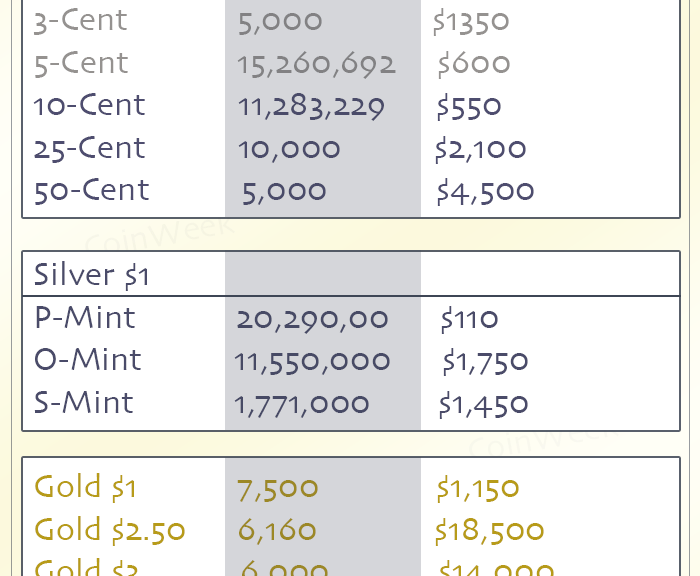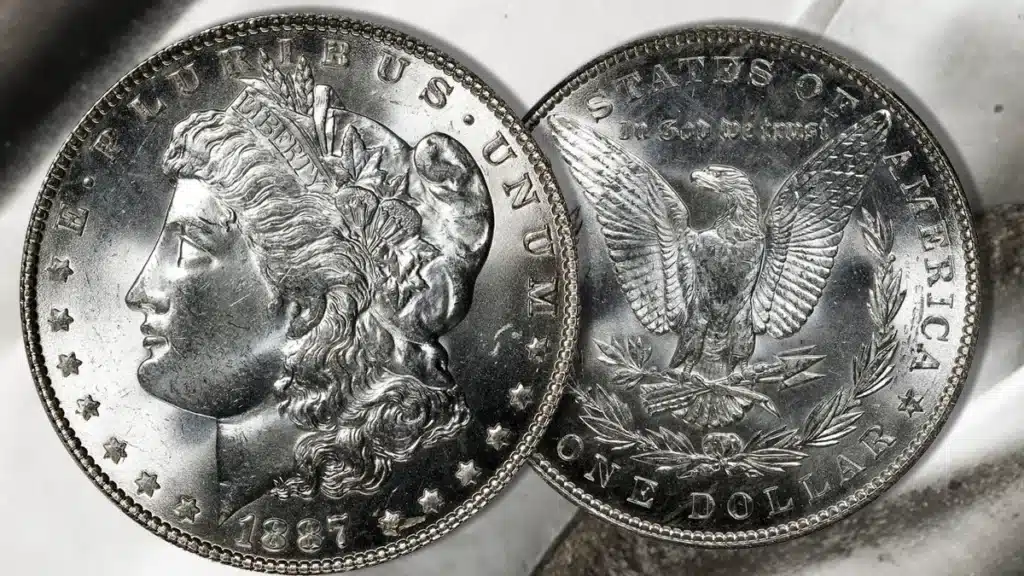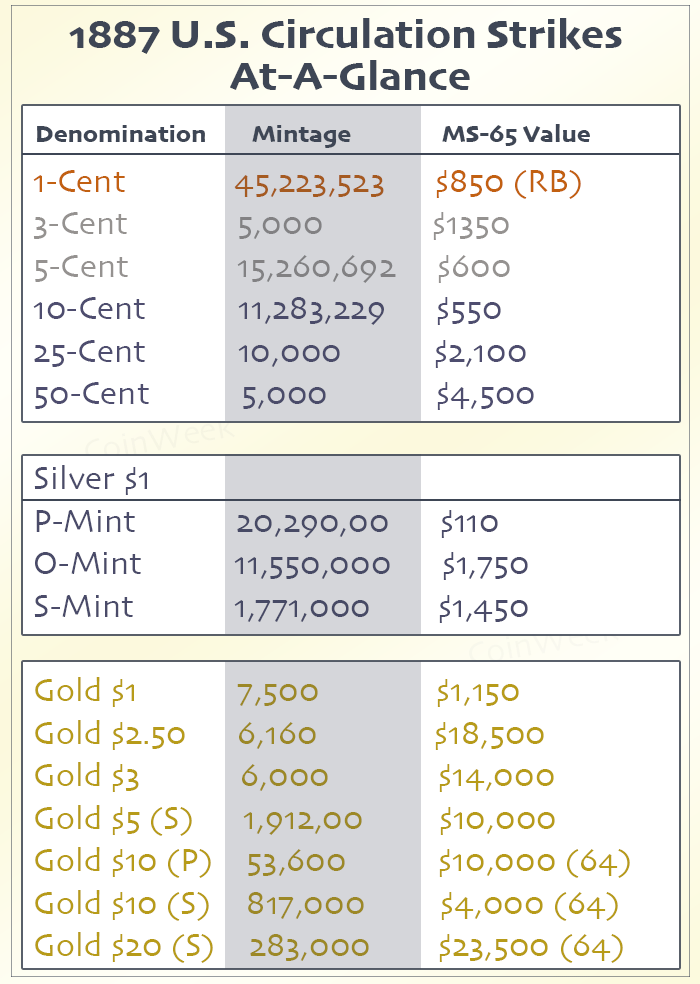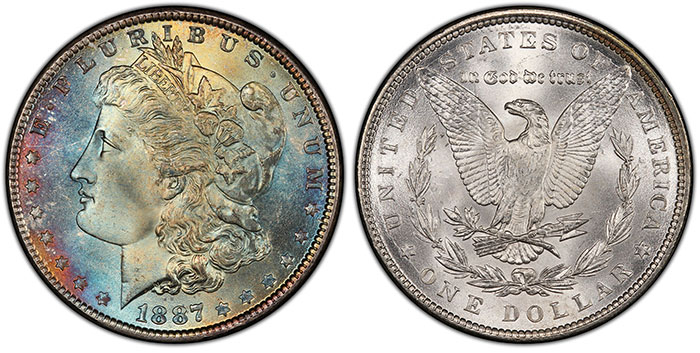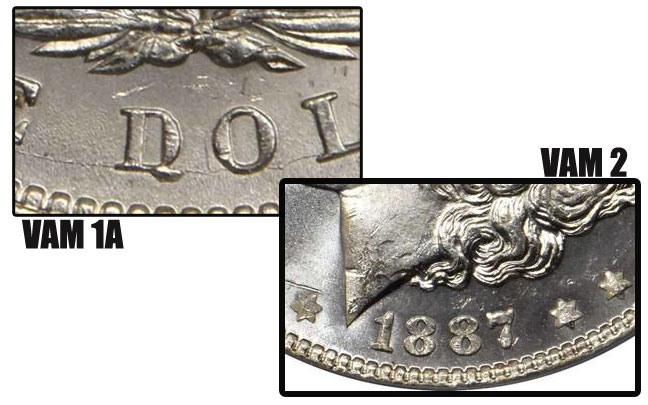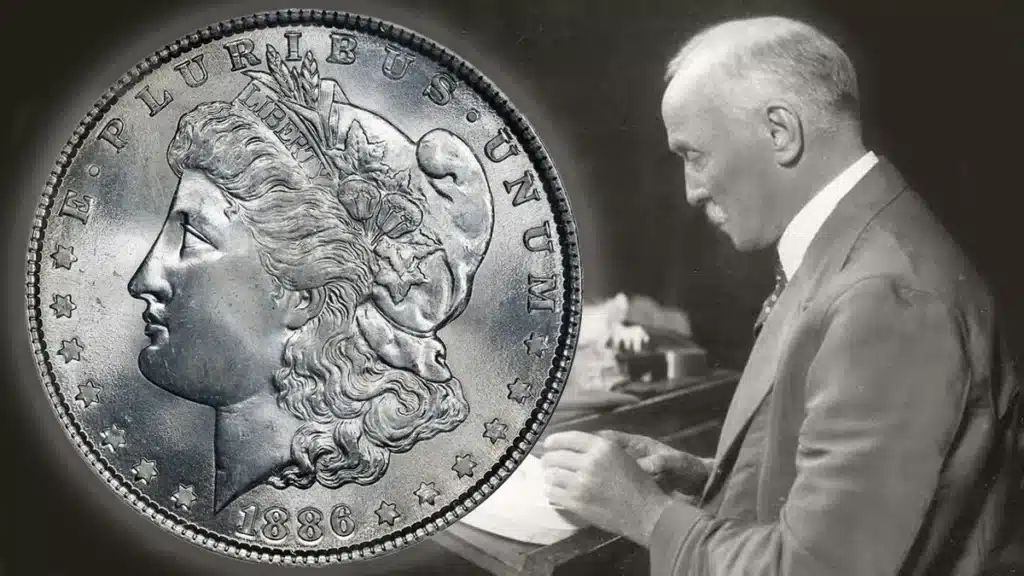
Millions of 1886 Morgan Dollars Were Struck and Stored
The Philadelphia Mint, being the main mint of the United States, was responsible for producing coins for the America’s mid-Atlantic, New England, and for the populated region of the midwest. The Mint’s branches in New Orleans, Carson City, and San Francisco produced coins in silver and gold for the South and West. All four of these mints were put to task striking millions of Morgan dollars in accordance with a federal law passed in 1878. Demand for these large silver coins in most regions of the country was modest at best, and the surplus of unwanted silver dollars sat in bags in Treasury vaults for decades.
By 1886, eight years into these silver dollar scheme, this lack of demand was acutely felt by the Mint and production levels at each branch was largely based on which location had the capacity to store the coins. While mintages at the branch mints fluctuated because of this, Philadelphia was offered no reprieve.
Coming into 1886, the Philadelphia had already produced 102,324,800 Morgan dollars. That year, Philadelphia would strike 19,963,000 more coins and still more the following year. It is because of these large mintages and the fact that so many coins were saved in large quantity in uncirculated condition that the Morgan dollar series saw a tremendous surge in collecting popularity in the 1960s and 1970s as silver coins disappeared from circulation.
What is the 1886 Morgan Dollar Worth?
The 1886 Morgan dollar is a coin that most hobbyists classify as common in all but the higher uncirculated grades. But this is only part of the story. Due to the fact that the coin has an actual silver weight of .77344 ounces of pure silver, every authentic 1886 Morgan dollar, regardless of condition is worth considerably more than the $1 face value stamped on the coin’s reverse. With silver prices approaching $25 an ounce, that puts a baseline value of a circulated 1886 Morgan dollar at about $19 in metal. Even this price is too low for the coin, as collectors will typically pay between $30 and $50 for circulated examples.
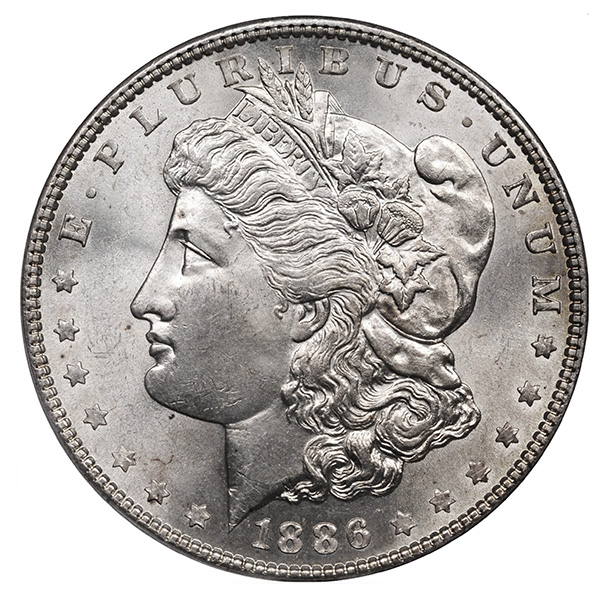
More often than not, collectors prefer uncirculated examples of common date Morgan dollars and the 1886 Morgan dollar is plentiful in brilliant uncirculated condition. The vallue of these coins depends on the assigned grade, the coin’s eye appeal, and to some extent, the service that encapsulated the coin. The three grading services that drive the certified Morgan dollar market are CAC, NGC, and PCGS.
Through November 2023, NGC counts 164,067 1886 Morgan dollars in its condition census, from that total 1,151 are noted as having Prooflike surfaces and 607 as having Deep Mirror Prooflike surfaces. The vast majority of these coins fall in the MS63 to MS64 grade band. In this grade range, the 1886 Morgan dollar sells for about $100 each.
PCGS counts 144,127 1886 Morgan dollars in its condition census. 1,251 of these are Prooflike, while 1,005 are Deep Mirror Prooflike. As was the case with NGC, PCGS considered most of the dollars submitted in the MS63 and MS64 grade range. At this level PCGS and NGC coins sell for about the same price: $100 each.
CAC has applied a CAC-approved sticker to NGC and PCGS-graded coins for the past sixteen years. In 2023, it launched a full service grading company with a location in Virginia Beach. To date, CAC has approved 3,512 1886 Morgan dollars with 62 approved with Prooflike and 69 Deep Mirror Prooflike. In addition, this year, the service has graded 81 1886 Morgan dollars, with a distribution of coins in the MS63 to MS66 range.
In Gem Uncirculated condition (MS65), the 1886 Morgan dollar sells for prices between $180 and $220. At this grade and higher, collectors pay large premiums for coins with exceptional eye appeal and toning. To date, PCGS reports one example at the grade MS68+ and estimates it’s value to be $20,000. Recent sales of MS68 coins have fallen in the $10,000 to $15,000 range. Less for coins graded by NGC. At this price point, the market value of an 1886 Morgan dollar is coin and time dependent.
Design
Obverse:
The obverse of the 1886 Morgan dollar exhibits the characteristic left-facing Liberty Head motif seen on all issues of this classic dollar series. The central Liberty bust wears a Phrygian cap encircled with a ribbon adorned with the inscription LIBERTY. Miss Liberty also wears a crown of wheat and cotton, which were two of the nation’s most lucrative natural agricultural assets in the 19th century.
The phrase E PLURIBUS UNUM is inscribed along the upper half of the obverse rim, and the date 1886 is centered at the bottom of the obverse adjacent to the rim. Seven stars appear between the left side of the date and the inscription E PLURIBUS UNUM, while six stars fill the gap between the date and motto on the lower right side of the coin. In total, the 13 stars symbolize the 13 colonies that combined to form the original Union of the United States. At the base of Liberty’s neck is the “M” monogram representing Morgan’s initial.
Morgan designed the Liberty head bust after the likeness of Anna Willess Williams, a Philadelphia schoolteacher who modeled for the coin. Williams received significant public recognition after her face appeared on the Morgan dollar, but she rejected the attention that was heaped upon her. She refused offers for acting roles and apparently had turned down an offer for marriage following her engagement to an unknown suitor. Before dying at the age of 68 in 1926, Williams, who sat for Morgan on the sworn condition of anonymity, rebuffed her single stint as a coin design model as little more than an “incident of my youth.”
Reverse:
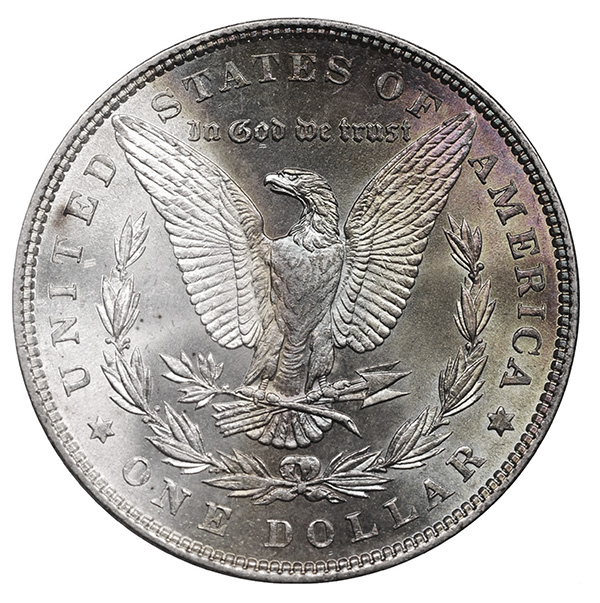 The reverse of the 1886 Morgan dollar is dominated by a heraldic eagle, its wings spread across the upper half of the coin. Between the upper tips of the eagle’s wings appears the motto IN GOD WE TRUST. The eagle clutches an olive branch in its right claw representing peace and in its left claw are three arrows symbolizing the nation’s ability to defend itself. The central eagle design is partly encircled by a laurel wreath.
The reverse of the 1886 Morgan dollar is dominated by a heraldic eagle, its wings spread across the upper half of the coin. Between the upper tips of the eagle’s wings appears the motto IN GOD WE TRUST. The eagle clutches an olive branch in its right claw representing peace and in its left claw are three arrows symbolizing the nation’s ability to defend itself. The central eagle design is partly encircled by a laurel wreath.
Along the rim of the upper two-thirds of the reverse is the legend UNITED STATES OF AMERICA, with the tip of the eagle’s left wings, which virtually touch the coin’s rim, interrupting the space between UNITED and STATES; the right wing visually divides the words OF and AMERICA. The words ONE DOLLAR, seen at the bottom center of the reverse, are flanked by a single, six-sided star on either side of the denomination inscription.
Edge:
The edge of the 1886 Morgan dollar is reeded.
Designer
Engraver George T. Morgan was born in Birmingham, England in 1845. He emigrated to the United States and began work as an assistant to Mint Chief Engraver William Barber and continued to produce patterns and commemoratives under the administration of Barber’s son, Charles. Morgan himself became Chief Engraver in 1917. He died in 1925.
Coin Specifications
| Country: | United States |
| Year Of Issue: | 1886 |
| Denomination: | 1 Dollar |
| Mint Mark: | None (Philadelphia) |
| Mintage: | 19,963,000 (Business Strike); 886 (Proof) |
| Alloy: | 90% Silver, 10% Copper |
| Weight: | 26.73 grams |
| Diameter: | 38.10 mm |
| Edge | Reeded |
| OBV Designer | George T. Morgan |
| REV Designer | George T. Morgan |
| Quality: | Business Strike, Proof |
The post 1886 Morgan Dollar : A Collector’s Guide appeared first on CoinWeek: Rare Coin, Currency, and Bullion News for Collectors.
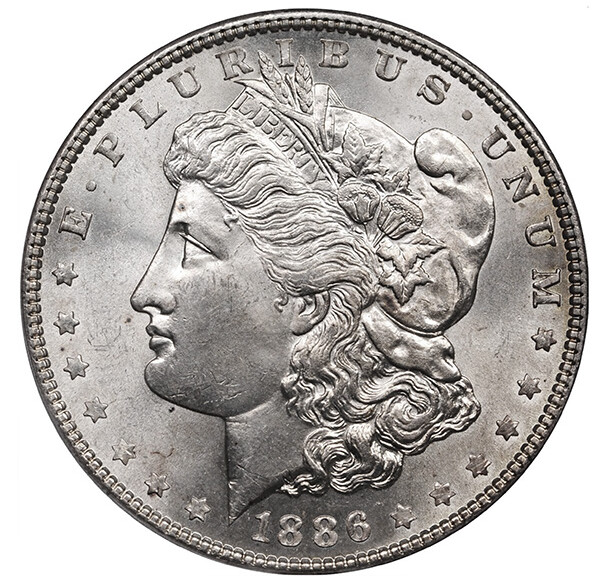
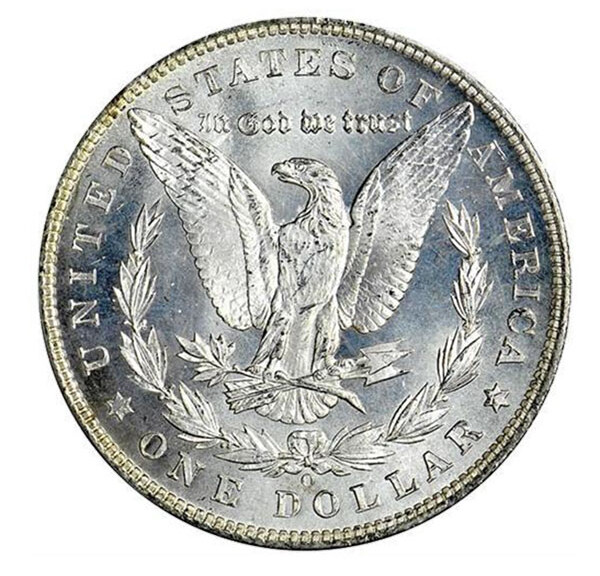

 Reverse:
Reverse: